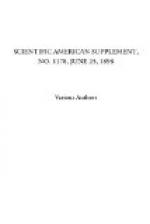* * * * *
AMATEUR CHRONOPHOTOGRAPHIC APPARATUS.
At the time that we described the Demeny chronophotographic apparatus we remarked that it had the advantage of permitting of the projection of very luminous images of large dimensions; but it is certain that the cases are somewhat limited in which there is any need of using a screen 24 or 25 feet square, and, as a general thing, one 6 or 10 feet square suffices. The manufacturer of the apparatus, M. Gaumont, has, therefore, been led to construct a small size in which the bands have the dimensions usually employed in the French and other apparatus, thus permitting of the use of such as are now found in abundance in the market.
By reducing the size, it has been possible further to simplify the construction, and at the same time to reduce the price, thus making of the new form a genuine amateur apparatus.
It will be remembered that the Demeny principle consists especially in the avoiding of traction upon the perforated part of the band, which is the portion that always presents the most fragility. This principle has naturally been preserved in the small model, and a preservation of the bands for a long time is thus assured.
[Illustration: Fig. 1—Arrangement of the sensitized band in two magazines.]
[Illustration: Fig. 2—Arrangement for taking views with special Gearing for the winding of the band.]
The apparatus is reversible, and may be used for making negatives as well as for projecting positives. In its new form it is easily transportable and is no more bulky than an ordinary 5 by 7 inch apparatus. Nothing is simpler then than to carry it on a journey, if one desires to make his own negative bands. Since the sensitized film has to be protected against the light during its entire travel, two magazines have been arranged (Fig. 1). One of these, A, which is fixed upon the top of the camera, contains the clean film, while the other, B, which is placed beneath the objective, receives the strip after it has been acted upon by the light. A train of toothed wheels, C (Fig. 2), actuates the roller of this second magazine. This arrangement may, moreover, be utilized also when projections are made, if one does not desire the band to float in measure as it unwinds behind the objective. As the upper magazine is entirely closed when it is placed upon the apparatus, it is necessary, in order to prepare for taking a negative, to pull out a few inches of the film, pass the latter over the guide roller and fix the extremity to the winding roller in the lower magazine.
It is clear that we can have any number of magazines whatever for carrying about, all charged, just as one carries the frames of his ordinary camera.




